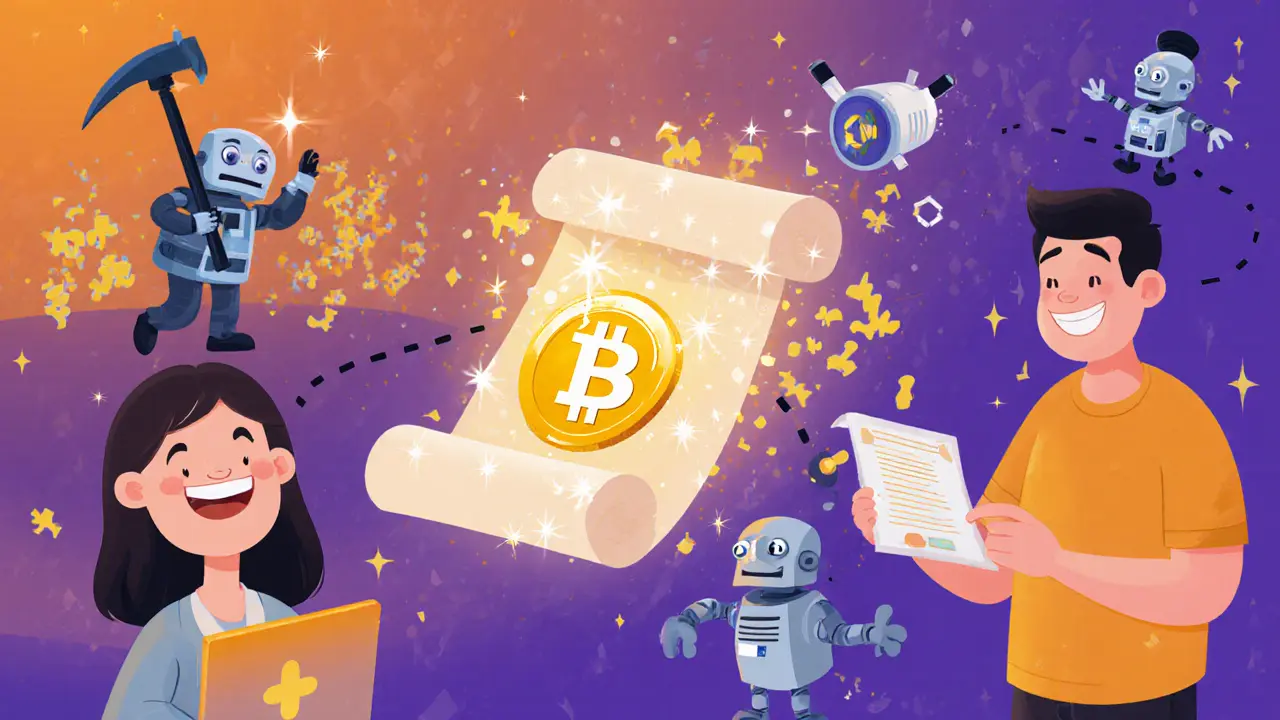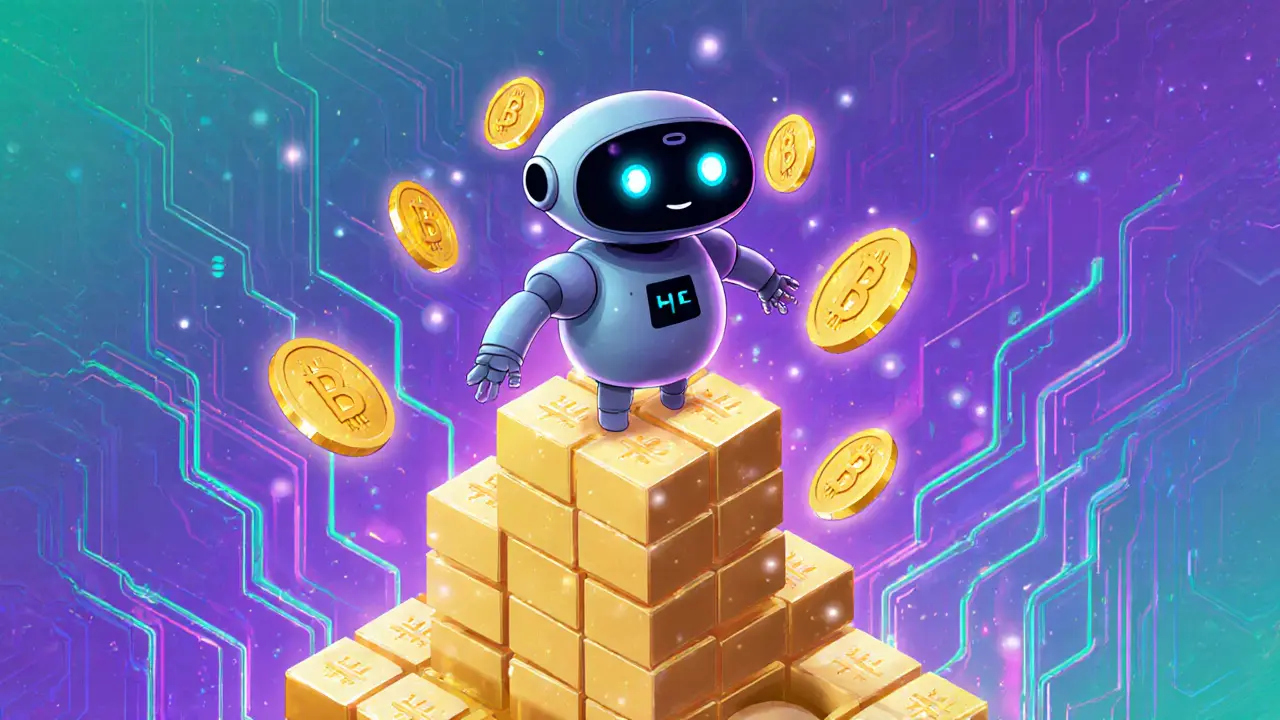
- 22 Apr 2025
- Elara Crowthorne
- 18
Cryptocurrency Basics Explorer
Click on the cards below to learn about key aspects of how cryptocurrency works.
What is Cryptocurrency?
Digital money that exists online without needing banks to validate transactions.
Blockchain Technology
The public ledger that records all cryptocurrency transactions securely.
Transactions
How money moves from one person to another using digital signatures.
Mining & Consensus
How computers solve puzzles to validate transactions and secure the network.
Wallets & Keys
How you store, secure, and access your cryptocurrency holdings.
Coins vs Tokens
Understanding the difference between native cryptocurrencies and tokenized assets.
When people mention cryptocurrency a digital currency that runs on a decentralized network using cryptographic security, they’re talking about money that lives entirely online and doesn’t need a bank to validate transactions. In this guide we’ll strip away the hype and walk through exactly how it works, step by step, so you can understand the tech behind the buzz.
What Is Cryptocurrency?
At its core, a cryptocurrency is a type of digital asset that can be transferred between users without a middleman. Each unit-often called a coin or token-exists as a record on a public ledger. The ledger is maintained by thousands of computers worldwide, making it extremely hard for anyone to tamper with the data.
Unlike fiat money, which governments issue and control, cryptocurrencies are created by software protocols. The first such protocol, Bitcoin, launched in 2009 and proved that a trust‑less money system could actually function.
Blockchain: The Backbone of Crypto
All major cryptocurrencies rely on blockchain an open, immutable ledger that records every transaction in linked blocks. Think of a blockchain as a giant spreadsheet that’s duplicated across a network of computers. When a new transaction occurs, it’s bundled with others into a "block". Each block contains a unique cryptographic fingerprint called a hash, plus the hash of the previous block, forming an unbreakable chain.
This structure solves the classic "double‑spending" problem: because every node (computer) holds a copy of the ledger, a fraudster can’t simply rewrite history without convincing the entire network-a practically impossible feat.
From Alice to Bob: How a Transaction Happens
Imagine Alice wants to send 0.5 Bitcoin to Bob. Here’s what she does:
- She opens her wallet software that holds private keys and creates signed transaction messages and enters Bob’s public address and the amount.
- The wallet signs the request with Alice’s private key-an unreadable string that proves she owns the funds.
- The signed message is broadcast to the node any computer that participates in the network by relaying and validating data network.
- Nodes gather Alice’s transaction with dozens of others and hand them to miners (or validators) for inclusion in the next block.
- Once a miner solves the cryptographic puzzle, the new block is added to the blockchain, and Alice’s payment is considered confirmed.
Because each step is publicly visible, anyone can verify that the transaction was legitimate without needing a bank’s approval.

Mining and Consensus: Why Computers Solve Puzzles
The process that adds a block to the chain is called mining the act of solving a cryptographic puzzle to validate transactions and create new coins in proof‑of‑work (PoW) systems like Bitcoin. Mining serves two purposes:
- It secures the network by making it computationally expensive to rewrite history.
- It introduces new coins into circulation as a reward for the miner’s effort.
Not all cryptocurrencies use PoW. Many newer chains adopt proof of stake a consensus method where validators lock up tokens as collateral instead of solving puzzles. PoS dramatically reduces energy consumption because “validators” are chosen proportionally to the amount they stake rather than by brute‑force computation.
| Feature | Proof of Work (PoW) | Proof of Stake (PoS) |
|---|---|---|
| Energy Use | High (mining rigs consume large amounts of electricity) | Low (validators use regular servers) |
| Security Model | Computational difficulty prevents attacks | Economic stake discourages malicious behavior |
| Reward Mechanism | New coins + transaction fees | Transaction fees (often higher yields from staking) |
| Typical Examples | Bitcoin, Ethereum (pre‑Merge) | Ethereum (post‑Merge), Cardano, Solana |
Wallets, Keys, and Ownership
Owning crypto isn’t about holding a physical object. It’s about controlling a private key-a long, random string of characters. The private key lets you sign transactions, proving you are the rightful owner of the coins linked to a public address.
Wallets come in several flavors:
- Hardware wallets store keys offline, offering the highest security.
- Software wallets run on phones or desktops and are convenient for daily use.
- Custodial wallets are provided by exchanges; they hold the keys for you, which is convenient but means you trust a third party.
Never share your private key or recovery phrase. If someone gets it, they can move your funds instantly.
Coins vs Tokens: What’s the Difference?
Most people lump all digital assets together, but there’s a technical split:
- Coin a native cryptocurrency that operates on its own blockchain (e.g., Bitcoin, Ether) serves primarily as money.
- Token a digital asset built on top of an existing blockchain, often used for utilities, governance, or assets (e.g., USDC on Ethereum, UNI for Uniswap).
Coins usually act as a store of value or medium of exchange, while tokens can represent anything from game items to shares in a DAO.
Real‑World Uses and Common Risks
Cryptocurrencies are more than speculative toys. They enable:
- Cross‑border payments that settle in minutes, not days.
- Smart contracts-self‑executing agreements that run on platforms like Ethereum without a lawyer.
- Decentralized finance (DeFi) services such as lending, borrowing, and yield farming.
- Tokenized assets, where real‑world items like real estate are represented on‑chain.
However, the space is volatile. Prices can swing 20% in a single day, and security breaches still happen. Always research a project, use reputable exchanges, and never invest more than you can afford to lose.
Key Takeaways
- Cryptocurrency is digital money secured by cryptography and recorded on a blockchain.
- Blockchain ensures transparency and immutability through linked blocks and consensus mechanisms.
- Transactions are signed with private keys and validated by miners or validators.
- Mining (PoW) and staking (PoS) are the two main ways networks stay secure and create new tokens.
- Controlling a private key equals ownership; keep it safe.
Frequently Asked Questions
What makes a cryptocurrency different from regular digital money?
Regular digital money (like a bank balance) is still tied to a central institution that records and validates every transaction. Cryptocurrency removes that middleman, storing every transfer on a public, tamper‑proof ledger called a blockchain.
Do I need a special computer to mine Bitcoin?
Yes. Bitcoin mining now requires ASIC machines-purpose‑built hardware that can solve the proof‑of‑work puzzle trillions of times per second. Using a regular PC is no longer viable.
Can I lose my cryptocurrency if my wallet is hacked?
If a hacker obtains your private key or recovery phrase, they can move your funds instantly. That’s why hardware wallets and offline backups are strongly recommended.
What is a smart contract?
A smart contract is code stored on a blockchain that automatically executes when predefined conditions are met, removing the need for an intermediary.
Is cryptocurrency legal?
Legality varies by country. Many governments allow buying, selling, and holding crypto but impose tax and AML regulations. Always check local laws before investing.




18 Comments
Great start! This guide does a solid job breaking down the basics without drowning you in jargon. I especially liked the way it explains private keys as the real “owner” of crypto. Keep it simple and clear, and newbies will feel more confident diving in.
When you strip away the hype, crypto really is a social experiment in trust‑less consensus. It forces us to rethink what “money” means when no central authority is involved. The blockchain acts like a collective memory that no single party can rewrite, which is both fascinating and a bit unsettling.
Awesome article!!! The step‑by‑step cards make the whole thing feel like a video game tutorial!!! I love how the mining section actually shows why proof‑of‑work isn’t just “random computing”. It’s a real security game!!!
Whoa, this explination is like a digital treasure map!!! I love how the writer uses simple terms, but there are a few typo’s that make me giggle. The part about wallets being “key‑boxes” is spot on – you gotta keep that key safе!
Keep learning, and the crypto world will start making sense.
Reading this felt like a friendly tour through a futuristic city. The analogies, like calling a blockchain a giant spreadsheet, really click for people who aren’t tech‑savvy. Also, the breakdown of coins vs tokens clears up a common confusion. I’d add a quick note on how to pick a reputable wallet, just to be safe. Overall, great work simplifying a complex topic.
It’s easy to get swept up in the hype, but let’s not ignore the shadow side of this so‑called financial revolution. First, the mining rigs that power Bitcoin’s proof‑of‑work consume more electricity than some small countries, raising serious environmental concerns. Second, the promise of decentralization often masks the fact that a handful of large exchanges control the majority of trading volume, creating a new kind of central authority. Third, the anonymity features that attract privacy enthusiasts also lure illicit actors who exploit crypto for money‑laundering. Fourth, the volatile price swings turn many users into gamblers rather than investors, which can erode financial stability. Fifth, the open‑source nature of many projects invites both innovation and ruthless copy‑cats who profit off ideas without contributing. Sixth, regulatory uncertainty means that tomorrow’s law could render today’s holdings illegal overnight. Seventh, the complexity of private keys means that a simple mistake can lead to irreversible loss of assets. Eighth, the narrative that crypto is “borderless” ignores the reality that network latency and geography still affect transaction speed. Ninth, many so‑called “smart contracts” are riddled with bugs that have already caused multimillion‑dollar hacks. Tenth, the tokenization of real‑world assets can create false security, as the underlying assets might not be properly verified. Eleventh, the community’s culture sometimes glorifies “no‑regulation” as a virtue, dismissing legitimate consumer protection concerns. Twelfth, the hype cycles produce boom‑bust patterns reminiscent of historical financial bubbles. Thirteenth, the promise of “financial inclusion” is overstated when many underserved populations lack reliable internet. Fourteenth, the sheer number of projects-over ten thousand-makes it impossible for an average investor to conduct proper due diligence. Fifteenth, all of these factors together suggest that we should approach crypto with a healthy dose of skepticism and thorough research before diving in.
Love the clear layout – it makes the concepts less intimidating 😊. The way you illustrated wallets and keys really helped me visualize how to keep my coins safe.
While the article admirably attempts to demystify a complex subject, it nevertheless suffers from a paucity of quantitative analysis; the absence of concrete transaction throughput figures, for instance, undermines its educational value, and the reliance on qualitative descriptions fails to satisfy the discerning reader who seeks empirical rigor.
Just a quick note: the “proof‑of‑stake” section could mention that validators are typically chosen pseudo‑randomly based on stake weight, which helps prevent centralization.
Hey folks, great discussion! Just to add, not all “tokens” are built on Ethereum – there are thriving ecosystems on Binance Smart Chain, Solana, and others, so keep an eye out for diversity beyond just ETH.
Reading through this guide reminded me of the first time I tried to explain blockchain to my grandparents; I had to start with the concept of a public ledger that everyone can see but no one can alter without consensus. The analogy of a spreadsheet that lives on every computer really clicks, because it emphasizes redundancy and trust‑lessness. Moreover, the breakdown of mining versus staking is crucial, as many newcomers conflate the two and think all crypto requires massive energy consumption. By pointing out that proof‑of‑stake leverages economic incentives rather than brute‑force computation, the article demystifies a key evolution in the space. I also appreciate the clear warnings about private key security – “never share your recovery phrase” is a mantra we should all chant. Finally, the sections on real‑world use cases, like cross‑border payments and tokenized assets, give readers a glimpse of why this technology matters beyond speculative trading. Overall, a well‑structured, thorough, and approachable introduction.
Yo, if you’re gonna jump into crypto, remember it’s not a get‑rich‑quick scheme – hard work and responsibility still matter.
Honestly, the whole crypto hype feels like a circus right now – everyone’s shouting about the next big moonshot while the underlying tech quietly evolves in the background.
I hear you on the wallet advice – keeping a hardware device offline is the gold standard for security, especially when the market swings like a rollercoaster.
Adding to that, many users overlook the importance of backing up their recovery phrase in multiple physical locations; a fire or flood can destroy a single backup.
It’s disconcerting how some promoters glorify reckless speculation while ignoring the ethical implications of volatile markets on vulnerable investors.
Frankly, I’m skeptical of the whole “decentralized finance” narrative – without proper oversight, it just replaces traditional banks with a Wild West of unregulated schemes.